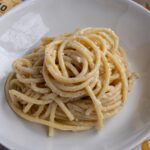Authentic Bucatini Cacio e Pepe (Roman Cheese and Pepper Pasta)
This authentic Bucatini Cacio e Pepe is a rustic cheese and pepper pasta hailing from Rome. It requires only three ingredients, producing one of the simplest yet most delicious pasta dishes, one that Anthony Bourdain himself said “could be the greatest thing in the history of the world.”
Servings: 2 servings
Calories: 523kcal
Ingredients
- 8 ounces (225 grams) dry bucatini (you could also use spaghetti)
- 1 teaspoon freshly grated black pepper plus more for serving
- ¾ cup (3 ounces / 85 grams) finely grated pecorino Romano cheese plus more for serving
- Kosher salt as needed
Instructions
- Bring salted water to a boil preferably in a large, deep saute pan or skillet (wide enough to fit the dry bucatini). Use less water than you normally would, so the resulting pasta water will be extra starchy. Cook the pasta until al dente.
- Meanwhile, in a small skillet over medium heat, toast the black pepper until fragrant, about 1 to 2 minutes. Add a ladle of the pasta water (it will sizzle) and set aside.
- Drain the pasta, reserving about 1 cup of starchy pasta water.
- Add the finely grated cheese to a large mixing bowl. Add the pepper and pasta water mixture, along with ¼ cup of the reserved hot starchy pasta water. Mix it vigorously with a fork or small whisk to create a smooth paste.
- Add the drained pasta and toss to coat, drizzling in more of the hot starchy pasta water as needed until you have a creamy, glossy sauce coating the pasta. (I added a total of about ⅔ cup starchy water including the initial ¼ cup). Alternatively, return the drained bucatini to the skillet you boiled it in, add the cheese paste and additional starchy pasta water and toss it together in there. The heat of the pan can help maintain the heat of the ingredients within as you mix.
- Serve immediately with additional black pepper and grated cheese if desired.
Notes
- Although bucatini cacio e pepe is best served immediately, if you have leftovers you can store them in an airtight container in the fridge for up to 5 days. Reheat in the microwave or in a nonstick skillet on the stove over medium low heat with a scant amount of water to help loosen the pasta back up as it heats through.
- The only cheese that should go in authentic cacio e pepe is pecorino Romano cheese. This is a Roman pasta dish and the cheese used should be local to that area. Some people use Parmigiano-Reggiano, but it has quite a different flavor profile, is less salty, and is simply not the same as what is normally used for this dish.
- Note that the sauce isn't clumping here, but it's just some pieces of cheese not fully dissolving with the residual heat of the water and pasta. It doesn't help that when taking step-by-step photos the food starts to cool down (whoops!). This doesn’t bother me as the sauce is quite silky otherwise.
Nutrition
Calories: 523kcal | Carbohydrates: 87g | Protein: 18g | Fat: 11g | Saturated Fat: 6g | Cholesterol: 24mg | Sodium: 690mg | Potassium: 15mg | Fiber: 4g | Sugar: 6g
